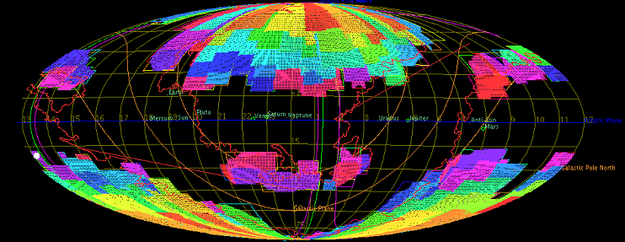Euclid mission sky coverage

Date: 24 April 2017
Satellite: Euclid
Copyright: ESA/Euclid consortium
This image shows the regions of the sky covered by the Euclid spacecraft during an example reference survey that could be carried out in a six-year nominal mission.
The mission, named Euclid after the ancient Greek mathematician, aims to study and map the geometry of the dark Universe, helping to solve some of cosmology’s most compelling mysteries in the process.
Planned for launch in 2020, Euclid will carry out a wide survey of some 15 000 square degrees of the sky, imaging around 1.5 billion galaxies during the nominal mission. An additional deep field survey will probe a region of about 40 square degrees in total.
Euclid will measure the distortion in the apparent shapes of galaxies with high precision. The light travelling from distant galaxies is perturbed by the gravity of cosmic structures – such as galaxy clusters – located between the galaxies and us, which distorts their images. By determining this distortion, we can map how dark and luminous matter are distributed in the clusters.
Euclid will also measure the redshifts of millions of galaxies, providing a 3D map of how galaxies are distributed in the Universe. Together, these measurements will allow Euclid to precisely determine the accelerated expansion of the Universe, explore how cosmic structures grow, as well as uncover the puzzle that is the nature of dark matter and dark energy.
This map is a Mollweide projection of the entire sky in ecliptic coordinates, the ecliptic North Pole is up. Euclid will observe areas that are not contaminated by light from the Solar System (the ecliptic plane, represented by the blue horizontal line), from the Milky Way (the galactic plane, the u-shaped band in orange), or where there is high extinction by galactic dust, which obscures the cosmological signal (red wavy line). The different colours are associated with a six-month period in which the whole sky is accessible by Euclid. During the primary mission there are 12 such periods, indicated here by 12 different colours.
